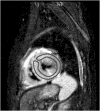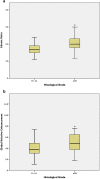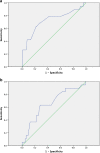Assessment of sub-clinical acute cellular rejection after heart transplantation: comparison of cardiac magnetic resonance imaging and endomyocardial biopsy
- PMID: 24895035
- PMCID: PMC4155184
- DOI: 10.1007/s00330-014-3246-2
Assessment of sub-clinical acute cellular rejection after heart transplantation: comparison of cardiac magnetic resonance imaging and endomyocardial biopsy
Abstract
Objective: Comparing the diagnostic value of multi-sequential cardiac magnetic resonance imaging (CMR) with endomyocardial biopsy (EMB) for sub-clinical cardiac allograft rejection.
Methods: One hundred and forty-six examinations in 73 patients (mean age 53 ± 12 years, 58 men) were performed using a 1.5 Tesla system and compared to EMB. Examinations included a STIR (short tau inversion recovery) sequence for calculation of edema ratio (ER), a T1-weighted spin-echo sequence for assessment of global relative enhancement (gRE), and inversion-recovery sequences to visualize late gadolinium enhancement (LGE). Histological grade ≥1B was considered relevant rejection.
Results: One hundred and twenty-seven (127/146 = 87 %) EMBs demonstrated no or mild signs of rejection (grades ≤1A) and 19/146 (13 %) a relevant rejection (grade ≥1B). Sensitivity, specificity, positive predictive, and negative predictive values were as follows: ER: 63 %, 78 %, 30 %, and 93 %; gRE: 63 %, 70 %, 24 %, and 93 %; LGE: 68 %, 36 %, 13 %, and 87 %; with the combination of ER and gRE with at least one out of two positive: 84 %, 57 %, 23 %, and 96 %. ROC analysis revealed an area under the curve of 0.724 for ER and 0.659 for gRE.
Conclusion: CMR parameters for myocarditis are useful to detect sub-clinical acute cellular rejection after heart transplantation. Comparable results to myocarditis can be achieved with a combination of parameters.
Key points: • Magnetic resonance imaging is useful for the assessment of cardiac allograft rejection. • CMR has a high negative predictive value for exclusion of allograft rejection. • Diagnostic performance is not yet good enough to replace endomyocardial biopsy.
Figures




Similar articles
-
Cardiac magnetic resonance imaging in heart transplant recipients with biopsy-negative graft dysfunction.ESC Heart Fail. 2024 Jun;11(3):1594-1601. doi: 10.1002/ehf2.14681. Epub 2024 Feb 20. ESC Heart Fail. 2024. PMID: 38379022 Free PMC article.
-
Cardiovascular Magnetic Resonance for Rejection Surveillance After Cardiac Transplantation.Circulation. 2022 Jun 21;145(25):1811-1824. doi: 10.1161/CIRCULATIONAHA.121.057006. Epub 2022 May 27. Circulation. 2022. PMID: 35621277 Clinical Trial.
-
Correlation of cardiovascular magnetic resonance imaging findings and endomyocardial biopsy results in patients undergoing screening for heart transplant rejection.J Heart Lung Transplant. 2015 May;34(5):643-50. doi: 10.1016/j.healun.2014.12.020. Epub 2015 Jan 8. J Heart Lung Transplant. 2015. PMID: 25934478
-
Cardiac transplantation: towards a new noninvasive approach of cardiac allograft rejection.Expert Rev Cardiovasc Ther. 2017 Apr;15(4):307-313. doi: 10.1080/14779072.2017.1307734. Epub 2017 Mar 21. Expert Rev Cardiovasc Ther. 2017. PMID: 28317398 Review.
-
Cardiovascular magnetic resonance in the diagnosis of acute heart transplant rejection: a review.J Cardiovasc Magn Reson. 2009 Mar 12;11(1):7. doi: 10.1186/1532-429X-11-7. J Cardiovasc Magn Reson. 2009. PMID: 19284612 Free PMC article. Review.
Cited by
-
Diagnostic performance of late gadolinium enhancement in the assessment of acute cellular rejection after heart transplantation.Anatol J Cardiol. 2016 Feb;16(2):113-8. doi: 10.5152/AnatolJCardiol.2015.5961. Epub 2015 Jun 18. Anatol J Cardiol. 2016. PMID: 26467370 Free PMC article.
-
Alteration of Cardiac Deformation in Acute Rejection in Pediatric Heart Transplant Recipients.Pediatr Cardiol. 2017 Apr;38(4):691-699. doi: 10.1007/s00246-016-1567-4. Epub 2017 Feb 4. Pediatr Cardiol. 2017. PMID: 28161809
-
Comprehensive morphologic and functional imaging of heart transplant patients: first experience with dynamic perfusion CT.Eur Radiol. 2018 Oct;28(10):4111-4121. doi: 10.1007/s00330-018-5436-9. Epub 2018 Apr 30. Eur Radiol. 2018. PMID: 29713770
-
A Changing Paradigm in Heart Transplantation: An Integrative Approach for Invasive and Non-Invasive Allograft Rejection Monitoring.Biomolecules. 2021 Feb 1;11(2):201. doi: 10.3390/biom11020201. Biomolecules. 2021. PMID: 33535640 Free PMC article. Review.
-
Multi-modal imaging of the pediatric heart transplant recipient.Transl Pediatr. 2019 Oct;8(4):322-338. doi: 10.21037/tp.2019.08.04. Transl Pediatr. 2019. PMID: 31728325 Free PMC article. Review.
References
-
- Baraldi-Junkins C, Levin HR, Kasper EK, Rayburn BK, Herskowitz A, Baughman KL. Complications of endomyocardial biopsy in heart transplant patients. J Heart Lung Transplant. 1993;12:63–67. - PubMed
Publication types
MeSH terms
LinkOut - more resources
Full Text Sources
Other Literature Sources
Medical

